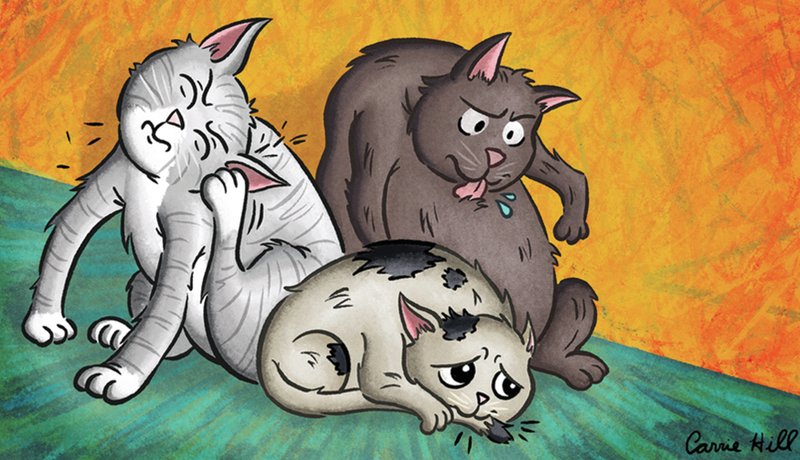Q I was recently diagnosed with obsessive-compulsive disorder. I live with two normal cats, but I've been wondering whether cats can have OCD, too.
A Yes, though veterinarians who specialize in behavior refer to the abnormal repetitive behaviors as "compulsive disorder," or CD, since the word "obsessive" refers to thought patterns we can't objectively evaluate in cats.
Feline compulsive disorder manifests most often as either excessive grooming to the point of baldness, or sucking on, chewing or ingesting fabric or other nonfood items. Additional CD behaviors include pacing, tail chasing, sucking the tail tip and chewing the claws.
The abnormal behaviors usually begin around age 2, although they may start earlier in breeds genetically predisposed to CD. The condition is often preceded by a major environmental change or other stressful event, such as moving to a new home, the death of a favorite animal companion or separation from an important human family member.
Key to making the diagnosis is to rule out other conditions. For example, excessive grooming can be caused by pain or itchiness instead of CD.
The goal of treatment is to improve the cat's quality of life. Yelling, swatting and other forms of punishment make CD worse by increasing the cat's anxiety.
A board-certified veterinary behaviorist can recommend effective behavior modification, environmental enrichment, pheromones and medication.
Q I was having financial difficulties and couldn't afford a monthly flea/tick preventive for my dog, Tara. Now, I think she has walking dandruff from Cheyletiella mites. Can I restart Frontline after not using it for over two years, and will it kill the mites?
A Yes, you may restart Frontline Plus or Frontline Spray at any time. Fipronil, the active ingredient in Frontline, kills not only fleas and ticks but also the Cheyletiella (ky-leh-tee-EL'-ah) mites that cause walking dandruff.
Another inexpensive treatment is lime sulfur dips. This dip discolors white fur and jewelry, so follow the instructions. If you decide on lime sulfur, dip Tara every five to seven days for three to four weeks.
Yet another treatment option is a permethrin-containing dog insecticide applied to the skin, such as Vectra 3D.
Finally, your veterinarian can prescribe an oral or topical medication that kills Cheyletiella and other parasites.
Cheyletiella mites easily infect dogs, cats and rabbits. If Tara is infected, she probably has flakiness along her back and rump, and perhaps also itchiness, reddened skin and hair loss. The flakes of skin sometimes move slightly as the mites tunnel beneath them, so the disease is called "walking dandruff." A magnifying glass will help you find the mites.
These mites are extremely contagious, even to people, where they cause an itchy rash. Transmission is through exposure to an infected animal or bedding, upholstery or carpeting that holds the mites or their eggs.
To get rid of them, all pets in your home should be treated, and pet bedding needs to be washed. Fortunately, treatment is very effective.
If Tara's flaky skin persists, have her examined by her veterinarian, because excessive skin flakiness can result from conditions other than walking dandruff.
Lee Pickett, VMD, practices companion animal medicine in North Carolina. Contact her at
askthevet.pet
Style on 06/01/2020
